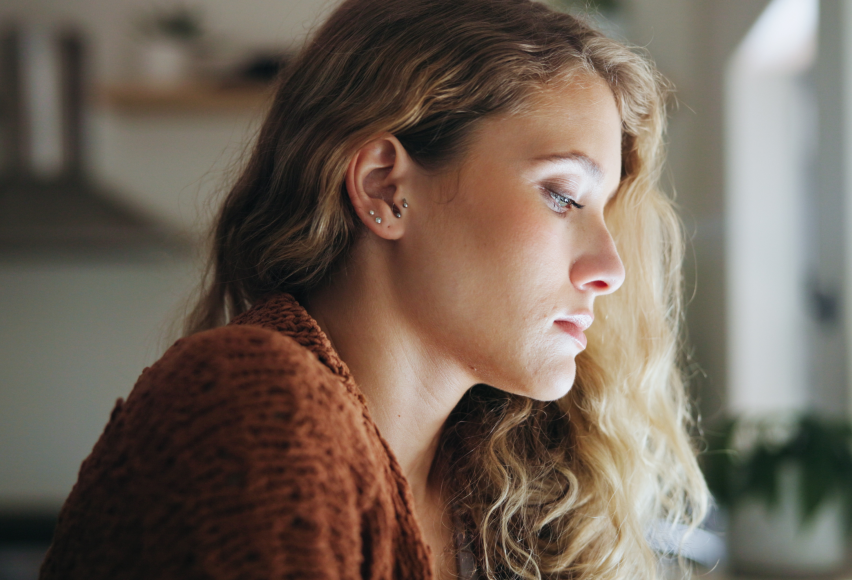Zoning Out: Managing Dissociation and Automaticity in Skin Picking

Online test
Find out the severity of your symptoms with this free online test
Dissociation, commonly referred to as “zoning out”, is a phenomenon often seen with various mental disorders, and most often associated with trauma exposure. Research suggests that traumatic life events may influence the pathway for OCD-related disorders like skin picking.
It is not uncommon for people with skin picking to experience episodes of picking that happen outside of their awareness. These bouts of picking are often referred to as “trances” and can be quite distressing. For many, these actions can feel automatic, disconnected, and difficult to control. Why do they happen and what can you do to manage this type of picking?
A Closer Look at Dissociation
Dissociation is a disruption or disconnect in the normal integration of one’s consciousness, memory, or perceptions. While extreme episodes can look like amnesia, mild dissociative episodes happen in everyday life too. If you’ve ever gotten completely “lost” in a book or lost in thought, you may have experienced mild dissociation.
While it can be maladaptive, dissociation is also thought to be a defense mechanism. For someone struggling with a difficult or traumatic experience, it may serve as a safe way to detach psychologically from events that are too overwhelming to cope with. While not everyone who has skin picking has also been exposed to significant trauma, recent research suggests that dissociation may mediate the relationship between these experiences and skin picking.
Dissociation is seen with a subtype of skin picking known as automatic skin picking. This type of picking happens outside of the person’s awareness and seems to be an effort to regulate some internal emotional distress. Often seen during times of boredom or stress or attending to something else like watching TV, attention turns inward, and in these skin picking trances, the person becomes completely absorbed in the experience of picking. They may become so engrossed in the picking that they may be completely unaware of what’s happening around them and may not even realize that they are picking until the episode is over.
Just how and why these episodes occur isn’t entirely clear, but research suggests that during these episodes, the brain enters a kind of "low-awareness" mode. Executive functioning, the part of the brain responsible for decision-making and impulse regulation, seems to become less active, allowing the habitual motor pathways to take over.
This blend of dissociation and automaticity creates a frustrating cycle: the behavior feels both intentional and unintentional at once. And that’s where the line gets blurry.
The Blurry Line of Consciousness
For many, the question is, is skin picking a conscious behavior or an unconscious one?
Evidence suggests the answer is both. It often starts with some conscious trigger such as a need to smooth a rough patch or remove a blemish. However, the picking can quickly veer off into the realm of unconsciousness. The picking occurs independently, sometimes for minutes or hours, while the mind remains unaware. It can be confusing because it’s not entirely voluntary or involuntary action. This in-between quality leaves you feeling confused, even blaming yourself for something that may be out of your awareness and control.
Blaming yourself for picking when much of the behavior is automatic, is neither fair nor productive. What can help is finding ways to increase awareness at the first signs of an impending dissociative episode or “trance” and using strategies that help you to recognize and manage urges.
Using Mindfulness to Build Awareness
Mindfulness practices, particularly those that focus on bodily awareness and present-moment attention, are promising tools for addressing the dissociative aspects of skin picking.
Mindfulness helps to bring your attention to the here and now and without judgment. It strengthens your brain's ability to notice subtle shifts in awareness before dissociation and automaticity take over.
Here are some mindfulness-based strategies clinicians recommend for managing skin picking:
1. Understand Your Trances
The first step is to understand how your dissociative episodes unfold and the experiences that shape them. For example:
- What do you think triggers your trances? Are your triggers internal or external?
- Where are you when your trances happen?
- What emotions are you struggling with or not understanding?
2. Daily Body Scans
A daily practice of scanning the body for sensations, tension, or urges can help individuals reconnect with physical sensations before they escalate into picking. Lying down or sitting quietly for 5–10 minutes, moving attention from the toes to the head, encourages early detection of discomfort that might otherwise trigger an episode.
3. Urge Surfing
Borrowed from addiction treatment, "urge surfing" involves observing the rise and fall of urges like waves. Instead of acting on the first impulse to pick, individuals are encouraged to notice the urge, label it ("this is an urge to pick"), and watch it crest and subside. This practice builds tolerance for discomfort without needing to react automatically.
4. Grounding Techniques
Because dissociation is at the heart of zoning out, grounding allows you to shift your focus onto something else and anchor yourself to that. A great grounding technique is popularly referred to as 5-4-3-2-1. Simply, you focus on five things you can see, four things you can hear, three things you can feel, two things you can smell, and one thing you can taste. As you do this, you’re shifting your focus away from the internal experience of the urge to bring the mind back to the present.
5. Mindful Replacement Behaviors
Rather than simply trying to stop picking, mindfulness-based therapy often encourages replacing it with a sensory activity that meets similar needs. For example, rubbing a textured stone, using a fidget toy, or applying lotion mindfully can satisfy tactile urges in a non-damaging way.
6. Redirect Your Energy
This is not a competing response strategy. Rather, this strategy entails physically shifting to something else. Walk your dog. Shoot some hoops. Look for some ways to expend energy. The trance state is driven by heightened anxiety which in itself is highly charged. The goal here is to find a way to expend that intense energy in safe ways.
Final Thoughts
Recognizing the role of dissociative states in skin picking shifts the conversation from blame to understanding. Skin picking is more than simply a bad habit. It’s a complex interaction between brain states, emotions, and behavior. Mindfulness-based strategies offer compassionate awareness and thoughtful actions to help you manage automatic picking.
References
1. Özten, E., Hızlı Sayar, G., Kağan, G., Işık, S., Karamustafalıoğlu, O., & Eryilmaz, G. (2015). The relationship of psychological trauma with trichotillomania and skin picking. Neuropsychiatric Disease and Treatment, 1203. https://doi.org/10.2147/ndt.s79554
2. Dissociative disorders. (n.d.). DSM Library. https://dsm.psychiatryonline.org/doi/full/10.1176/appi.books.9780890425787.x08_Dissociative_Disorders
3. Kłosowska, J., Antosz-Rekucka, R., Kałużna-Wielobób, A., & Prochwicz, K. (2021). Dissociative experiences mediate the relationship between traumatic life events and types of skin picking. Findings from non-clinical sample. Frontiers in Psychiatry, 12. https://www.frontiersin.org/journals/psychiatry/articles/10.3389/fpsyt.2021.698543/full
4. McKinnon, M. C., Boyd, J. E., Frewen, P. A., Lanius, U. F., Jetly, R., Richardson, J. D., & Lanius, R. A. (2016). A review of the relation between dissociation, memory, executive functioning and social cognition in military members and civilians with neuropsychiatric conditions. Neuropsychologia, 90, 210-234. https://www.sciencedirect.com/science/article/pii/S0028393216302615
5. SkinPick's October webinar: Exploring skin picking "Trances", pt. 1 [Video]. (2020, October 22). YouTube. https://youtu.be/yL2OaCVp1KE?si=7jzfhrbWGa2qG5ZH
6. Urge surfing — The BFRB club. (2023, April 2). The BFRB Club. https://www.thebfrbclub.com/bfrb-blog/urge-surfing
Online test
Find out the severity of your symptoms with this free online test
Start your journey with SkinPick
Take control of your life and find freedom from skin picking through professional therapy and evidence-based behavioral techniques.
Start Now



